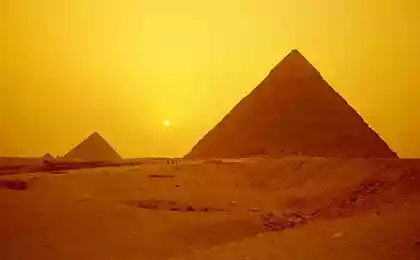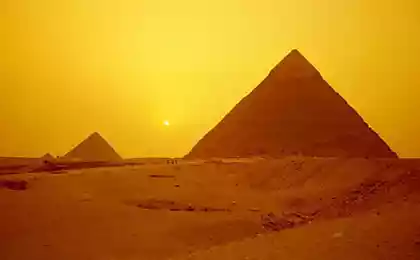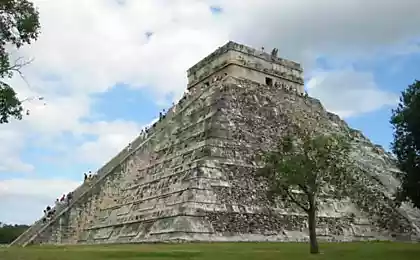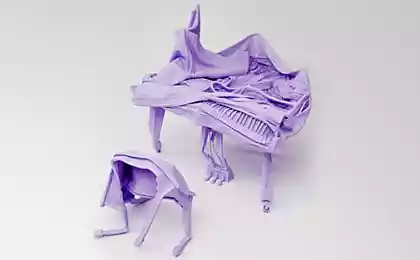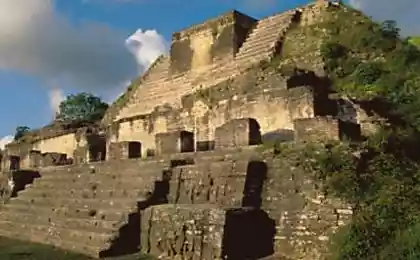1042
Do you believe in the existence of a highly developed civilization before us?
Could the ancient Egyptians to build their own giant pyramids and palaces? People who only read about these structures in the history books believe yes. But many of those who have been in this country and wandered, for example, the valley of Giza, are skeptical. Too, these impressive structures, even if their construction is supposed to have worked tens of thousands of slaves.
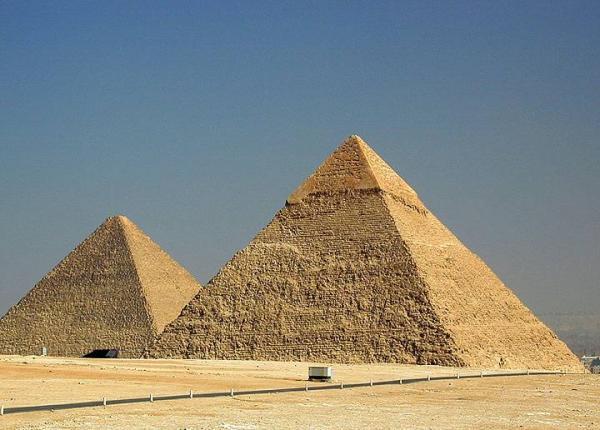
Version Conan Doyle
The theory that the pyramid - are tangible signs of some more technologically advanced ancient civilization, was not put forward today. For example, in 1929, "the father of Sherlock Holmes" Arthur Conan Doyle wrote a science fiction novel "The Maracot Deep", the characters that fall into a city - an island thousands of years ago, sank to the bottom of the Atlantic Ocean. When one examines the underwater structure, it notes that: "The columns, platforms and stairs of the building exceeded anything I have ever seen on earth. Most of the building was like the remains of the temple of Karnak in Luxor, Egypt, and, strange to say, decorations and half-erased inscription in trifles resembled the same decorations and inscriptions near the ruins of the great Nile ».
According to Conan Doyle, by the way, to visit Egypt before the writing of this novel, all local ancient structures were built by the Atlanteans. And Doyle, according to his contemporaries, as well as his famous character, detective, had brilliant analytical abilities.
Sphinx older than 5000 years?
Based on what its conclusions Conan Doyle, is not clear. But it now has many followers. For example, the head of the Laboratory of alternative history Andrey Sklyarov, who repeatedly visited Egypt claims that most of the local historical monuments of the ancient indeed created pratsivilizatsii:
- You can call them the Atlanteans can aliens can somehow differently, but their traces in Egypt incredible amount. It is strange that Egyptologists have never paid attention to it. Although now I have the impression that the Egyptians themselves of something guess, but well-kept secret.
- If possible, specific examples ...
- Please, let's start with the great sphinx. Classical Egyptology states that it was built during the time of Pharaoh Khufu, or his son - about 2, 5 thousand years BC - on the basis of a fact that their "artistic features" can be attributed to the era. But even half a century ago has been found in Giza so-called "Inventory Stela", which stated that Cheops ordered only to repair the damaged statue. Repair rather than build!
And in the early '90s American geologist Robert Schoch proved that the grooves on the body of the Sphinx and on the wall of a trench around it - no traces of erosion of wind and rain: vertical stripes instead of horizontal. But serious rains in Egypt, there was already at least 8000 years.
Immediately after the publication Schoch Egyptian authorities have started an urgent restoration of the Sphinx. Now the lower two-thirds of the monument closed new masonry and sculpture stripped top - almost no trace of erosion left. By the way, about the same time, it was hidden in the storerooms of the Cairo Museum and the "Inventory Stela" - before she was put on public display, and now instead put another. In response to questioning on this stele curator only puzzled shrug. But it has repeatedly described in the scientific and so-called alternative literature.
When the gods ruled ...
According to Andrei Sklyarov, something built by the ancient Egyptians themselves. But they built their buildings on the basis of ancient structures.
- This is clearly seen in the pyramids - which are made by hand, and which with the help of high-precision tools, - says Andrey. - Moreover, many ancient buildings remind bins - semi-subterranean structures on which to build their pyramids of the pharaohs, trying to copy the ancients. And the original pyramids, built pratsivilizatsiey, was only 6 - 7: three at Giza, two in Dashshure and one in Meduna. Perhaps another was Abu Roashe, but it is unclear whether a pyramid, or a bunker. And the other pyramid - is the completed construction of the ancient pharaohs, who initially represented the typical bunkers. And with such powerful beams that otherwise as a refuge in case of nuclear war, and they can not be called. However, it is unclear why and who they can threaten. But the war is just explains the disappearance pratsivilizatsii.
- Why, except buildings, no other material evidence?
- Why is not there? For example, in the Giza desert we came across what looked like iron dust. They took samples brought to Moscow. It was found that this iron oxide with a high content of manganese. The percentage corresponds to the high-manganese steel, which are now used in Truckee tanks and as a material for stone crushing machines. For many years, this highly durable steel could turn to dust in the desert, which is already 8000 years there was no decent rain.
- But what kind of a mysterious civilization has left us these artifacts?
- There are different versions. Someone holds the theory that it was the Atlanteans, someone talks about colonists from other worlds. When they came to earth, hard to say, but the heyday of their power can be defined. At the beginning of the III century BC. e. Egyptian historian Manetho published his "History of Egypt." Before our time it is fully preserved, but the passages referred to in the works of other historians of the first millennium BC already. Manetho was a chronological list of the country's rulers. Classical Egyptology recognizes only "part of the dynastic" in which we are talking about the famous pharaoh people. But Manetho tells about the first kingdom, when Egypt was ruled by the gods supposedly. It existed about 10 - 12 thousand years ago, long before the first known pharaohs.
They have been working with granite as a foam
- Egyptologists now spend their time in the debate, how these workers moved a multi-ton stone blocks that were building pyramids and temples, build version, conduct experiments, - says Andrey Sklyarov. - We went the other way: if there are millions of tons of stones, it is necessary to understand how they were treated. We analyzed a set of parameters. For example, if they are sawn, the look kerf width and depth, the thickness of the cutting edge. Sometimes the results are amazing.
Plates of black basalt, located on the perimeter of the temple, standing near the Great Pyramid (before they were ancient Egyptian temple floor). Visible trace of a circular saw, which is known to be working on the hydraulic, pneumatic or electric actuator, but the Egyptians did not have neither the first nor the second, nor the third.
Visibly and that when cutting is grinding. If, according to the builders working with hand saws copper, they would have scratches and a similar grinding leaves modern saws with diamond-coated, and they move at the same time have very quickly.
Detail of the obelisk at Karnak. It lies 10 meters from the tourist trail. It strange holes 1 cm in diameter and a depth of about 10 cm. Apparently they were made to strengthen some decorative plate: gold or copper. But some of them go deep into the granite is not perpendicular and at an angle of 10 - 20 degrees: it is impossible to do manually. It turns out that their granite drill, we drill holes in vert soft wood. What a drill ancient Egyptians could go into a granite, both in oil?
This obelisk, which lies near the famous scarab beetle on the banks of the sacred lake in Karnak. Visible decorative strip of 3 mm, a depth of 1 cm. It is believed that this kind of nail scratched. Jewellers, perhaps, could repeat carefully crashing with modern tools.
Artifact from the south of Saqqara, where tourists are not allowed. A very significant block of black basalt. The far side of his sawn off: visible trace of the saw blade. And another part of trying to handle manually. Immediately see the difference.
Gates is still in the closed part of the temple of Karnak. At the top of a hole in the granite, are believed to goalpost size of a good barrel. In our world of machines that can cut out these holes were only 10 - 15 years ago.
Aswan quarries. Pits, leaving a few meters deep. The diameter of a little more than the width of a human body. As such hollow pit? Is that standing upside down. There are many pits. According to Egyptologists, they are designed to look like the cracks are in the main array. And it is absolutely senseless, because it can determine the direction of the cracks and the surface. And why had so carefully align the wall? It seems that the mill worked here. There is a hypothesis that the builders simply took samples of granite. But such a tool that allows you to not spend a lot of time these samples. Pratsivilizatsiya This shows us that working with granite as a foam.
Andrey Moiseenko
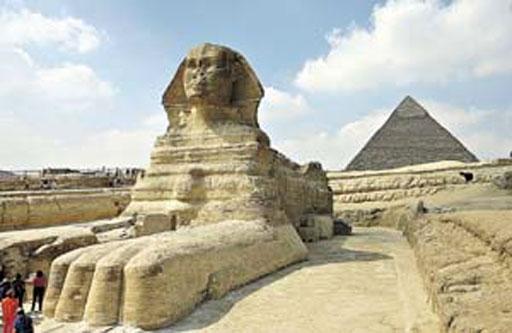
The exact age of the stone sculptures nobody knows
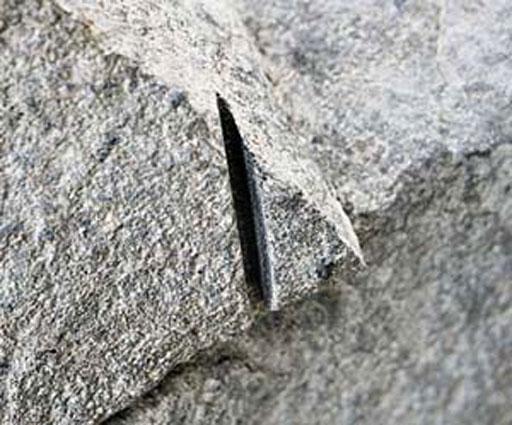
Plates of black basalt, located on the perimeter of the temple

Detail of the obelisk at Karnak
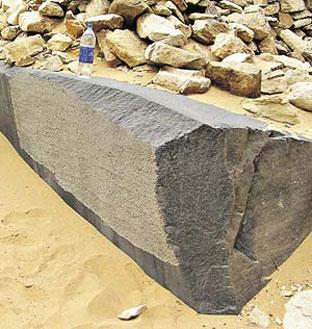
Artifact from the south of Saqqara, where tourists are not allowed
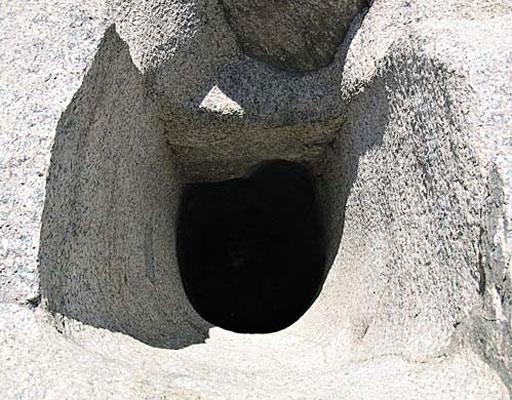
Gates is still in the closed part of the temple of Karnak
Can all the same to us lived an advanced civilization? What do you think?

Version Conan Doyle
The theory that the pyramid - are tangible signs of some more technologically advanced ancient civilization, was not put forward today. For example, in 1929, "the father of Sherlock Holmes" Arthur Conan Doyle wrote a science fiction novel "The Maracot Deep", the characters that fall into a city - an island thousands of years ago, sank to the bottom of the Atlantic Ocean. When one examines the underwater structure, it notes that: "The columns, platforms and stairs of the building exceeded anything I have ever seen on earth. Most of the building was like the remains of the temple of Karnak in Luxor, Egypt, and, strange to say, decorations and half-erased inscription in trifles resembled the same decorations and inscriptions near the ruins of the great Nile ».
According to Conan Doyle, by the way, to visit Egypt before the writing of this novel, all local ancient structures were built by the Atlanteans. And Doyle, according to his contemporaries, as well as his famous character, detective, had brilliant analytical abilities.
Sphinx older than 5000 years?
Based on what its conclusions Conan Doyle, is not clear. But it now has many followers. For example, the head of the Laboratory of alternative history Andrey Sklyarov, who repeatedly visited Egypt claims that most of the local historical monuments of the ancient indeed created pratsivilizatsii:
- You can call them the Atlanteans can aliens can somehow differently, but their traces in Egypt incredible amount. It is strange that Egyptologists have never paid attention to it. Although now I have the impression that the Egyptians themselves of something guess, but well-kept secret.
- If possible, specific examples ...
- Please, let's start with the great sphinx. Classical Egyptology states that it was built during the time of Pharaoh Khufu, or his son - about 2, 5 thousand years BC - on the basis of a fact that their "artistic features" can be attributed to the era. But even half a century ago has been found in Giza so-called "Inventory Stela", which stated that Cheops ordered only to repair the damaged statue. Repair rather than build!
And in the early '90s American geologist Robert Schoch proved that the grooves on the body of the Sphinx and on the wall of a trench around it - no traces of erosion of wind and rain: vertical stripes instead of horizontal. But serious rains in Egypt, there was already at least 8000 years.
Immediately after the publication Schoch Egyptian authorities have started an urgent restoration of the Sphinx. Now the lower two-thirds of the monument closed new masonry and sculpture stripped top - almost no trace of erosion left. By the way, about the same time, it was hidden in the storerooms of the Cairo Museum and the "Inventory Stela" - before she was put on public display, and now instead put another. In response to questioning on this stele curator only puzzled shrug. But it has repeatedly described in the scientific and so-called alternative literature.
When the gods ruled ...
According to Andrei Sklyarov, something built by the ancient Egyptians themselves. But they built their buildings on the basis of ancient structures.
- This is clearly seen in the pyramids - which are made by hand, and which with the help of high-precision tools, - says Andrey. - Moreover, many ancient buildings remind bins - semi-subterranean structures on which to build their pyramids of the pharaohs, trying to copy the ancients. And the original pyramids, built pratsivilizatsiey, was only 6 - 7: three at Giza, two in Dashshure and one in Meduna. Perhaps another was Abu Roashe, but it is unclear whether a pyramid, or a bunker. And the other pyramid - is the completed construction of the ancient pharaohs, who initially represented the typical bunkers. And with such powerful beams that otherwise as a refuge in case of nuclear war, and they can not be called. However, it is unclear why and who they can threaten. But the war is just explains the disappearance pratsivilizatsii.
- Why, except buildings, no other material evidence?
- Why is not there? For example, in the Giza desert we came across what looked like iron dust. They took samples brought to Moscow. It was found that this iron oxide with a high content of manganese. The percentage corresponds to the high-manganese steel, which are now used in Truckee tanks and as a material for stone crushing machines. For many years, this highly durable steel could turn to dust in the desert, which is already 8000 years there was no decent rain.
- But what kind of a mysterious civilization has left us these artifacts?
- There are different versions. Someone holds the theory that it was the Atlanteans, someone talks about colonists from other worlds. When they came to earth, hard to say, but the heyday of their power can be defined. At the beginning of the III century BC. e. Egyptian historian Manetho published his "History of Egypt." Before our time it is fully preserved, but the passages referred to in the works of other historians of the first millennium BC already. Manetho was a chronological list of the country's rulers. Classical Egyptology recognizes only "part of the dynastic" in which we are talking about the famous pharaoh people. But Manetho tells about the first kingdom, when Egypt was ruled by the gods supposedly. It existed about 10 - 12 thousand years ago, long before the first known pharaohs.
They have been working with granite as a foam
- Egyptologists now spend their time in the debate, how these workers moved a multi-ton stone blocks that were building pyramids and temples, build version, conduct experiments, - says Andrey Sklyarov. - We went the other way: if there are millions of tons of stones, it is necessary to understand how they were treated. We analyzed a set of parameters. For example, if they are sawn, the look kerf width and depth, the thickness of the cutting edge. Sometimes the results are amazing.
Plates of black basalt, located on the perimeter of the temple, standing near the Great Pyramid (before they were ancient Egyptian temple floor). Visible trace of a circular saw, which is known to be working on the hydraulic, pneumatic or electric actuator, but the Egyptians did not have neither the first nor the second, nor the third.
Visibly and that when cutting is grinding. If, according to the builders working with hand saws copper, they would have scratches and a similar grinding leaves modern saws with diamond-coated, and they move at the same time have very quickly.
Detail of the obelisk at Karnak. It lies 10 meters from the tourist trail. It strange holes 1 cm in diameter and a depth of about 10 cm. Apparently they were made to strengthen some decorative plate: gold or copper. But some of them go deep into the granite is not perpendicular and at an angle of 10 - 20 degrees: it is impossible to do manually. It turns out that their granite drill, we drill holes in vert soft wood. What a drill ancient Egyptians could go into a granite, both in oil?
This obelisk, which lies near the famous scarab beetle on the banks of the sacred lake in Karnak. Visible decorative strip of 3 mm, a depth of 1 cm. It is believed that this kind of nail scratched. Jewellers, perhaps, could repeat carefully crashing with modern tools.
Artifact from the south of Saqqara, where tourists are not allowed. A very significant block of black basalt. The far side of his sawn off: visible trace of the saw blade. And another part of trying to handle manually. Immediately see the difference.
Gates is still in the closed part of the temple of Karnak. At the top of a hole in the granite, are believed to goalpost size of a good barrel. In our world of machines that can cut out these holes were only 10 - 15 years ago.
Aswan quarries. Pits, leaving a few meters deep. The diameter of a little more than the width of a human body. As such hollow pit? Is that standing upside down. There are many pits. According to Egyptologists, they are designed to look like the cracks are in the main array. And it is absolutely senseless, because it can determine the direction of the cracks and the surface. And why had so carefully align the wall? It seems that the mill worked here. There is a hypothesis that the builders simply took samples of granite. But such a tool that allows you to not spend a lot of time these samples. Pratsivilizatsiya This shows us that working with granite as a foam.
Andrey Moiseenko

The exact age of the stone sculptures nobody knows

Plates of black basalt, located on the perimeter of the temple

Detail of the obelisk at Karnak

Artifact from the south of Saqqara, where tourists are not allowed

Gates is still in the closed part of the temple of Karnak
Can all the same to us lived an advanced civilization? What do you think?

